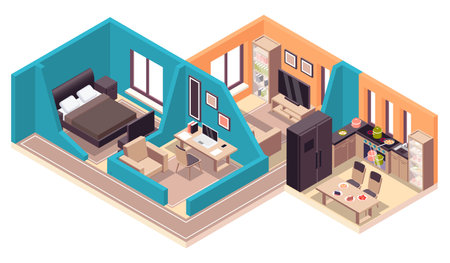Introduction to Wellbeing in British Homes
In the heart of every British home lies a unique tapestry of tradition, comfort, and daily rituals that shape our sense of wellbeing. As we spend a significant portion of our lives indoors, the quality of our living environment directly influences our mood, health, and productivity. The British climate, often characterised by its grey skies and fleeting sunshine, presents both a challenge and an opportunity for homeowners seeking to enhance their lifestyle. Within this context, natural light emerges as a subtle yet powerful force in transforming domestic spaces. Not only does it brighten interiors and accentuate architectural features, but it also plays a crucial role in regulating our circadian rhythms and emotional balance. As we explore the science behind wellbeing at home, it becomes clear that harnessing the benefits of natural light is not just an aesthetic choice—it’s fundamental to creating uplifting and productive living spaces across Britain.
2. The Science Behind Natural Light and Human Health
Recent research has illuminated the profound effects of natural daylight on our physical and mental wellbeing, particularly in the unique context of British homes where seasonal variations can be dramatic. Exposure to daylight is more than a mere aesthetic preference—it plays an essential role in regulating mood, supporting our circadian rhythms, and enhancing productivity. Let’s delve into the latest scientific findings that reveal why letting in more sunlight could be transformative for your home environment.
Mood Regulation: The Natural Antidepressant
Natural light stimulates the production of serotonin, a key neurotransmitter that contributes to feelings of happiness and calm. In the UK, where overcast skies are common, insufficient daylight exposure has been linked to Seasonal Affective Disorder (SAD) and general mood dips. By maximising natural light indoors, residents can help counteract these effects, fostering a brighter emotional outlook even during the cloudiest months.
Circadian Rhythm: The Bodys Internal Clock
The circadian rhythm is an intrinsic 24-hour cycle that governs sleep-wake patterns, hormone release, and metabolic processes. Research from leading UK universities shows that regular exposure to morning sunlight helps synchronise this internal clock, resulting in better sleep quality and overall health. Conversely, poor daylight exposure can disrupt these rhythms, leading to fatigue and lowered immunity.
Natural Light and Productivity: A Direct Correlation
Productivity at home—whether for remote working or study—benefits significantly from increased daylight. Studies indicate that rooms bathed in natural light enhance concentration levels, reduce eye strain, and lower stress compared to spaces lit solely by artificial means. This is especially pertinent for British households adapting to hybrid work environments.
| Aspect | Impact of Natural Light |
|---|---|
| Mood | Elevates serotonin levels; reduces SAD risk |
| Circadian Rhythm | Improves sleep quality; stabilises energy levels |
| Productivity | Boosts focus; lowers stress; reduces fatigue |
By understanding the science behind daylight’s influence on wellbeing, British homeowners can make informed decisions about their living spaces—transforming not just how their homes look, but how they feel and function throughout the year.

3. Challenges with Natural Light in UK Homes
Despite the proven benefits of natural light, British homes face unique challenges that can limit exposure to daylight. The architectural heritage of the UK is rich and varied, yet it often includes features that restrict the flow of sunlight indoors. The prevalence of terraced houses—a hallmark of British residential design—means many homes share walls on both sides, reducing opportunities for windows and limiting the angles through which daylight can enter living spaces. This traditional layout, while charming and efficient in terms of land use, can result in darker interiors, particularly in long, narrow rooms or hallways.
Climatic conditions further complicate access to natural light. The UK is renowned for its overcast skies and frequent rainfall, especially during autumn and winter months when days are shorter and sunlight is at a premium. These weather patterns contribute to lower levels of ambient light filtering into homes. Even in newer developments, window size and orientation are sometimes dictated more by planning regulations than by optimal daylighting principles.
Additionally, historic preservation rules often limit the extent to which homeowners can modify facades or enlarge windows in period properties. This means that many residents must find creative solutions to maximise what little sunlight is available. The combination of climate, architecture, and regulation creates a distinct set of challenges for enhancing wellbeing through natural light within British domestic environments.
4. Enhancing Natural Light: Architectural and Interior Solutions
Maximising natural light within British homes not only elevates mood but also creates spaces that feel open, inviting, and effortlessly elegant. Rooted in the distinctive aesthetics of British design—where functionality gracefully meets tradition—there are myriad practical strategies for drawing daylight deeper into every room. Whether you reside in a Victorian terrace, a Georgian townhouse, or a contemporary flat, carefully considered choices in architecture and interiors can dramatically transform the ambience of your living environment.
Bay Windows: A Classic British Feature
Bay windows are an iconic element of British architecture, especially prevalent in period homes across London, Manchester, and Edinburgh. These projecting window structures extend beyond the external wall, capturing sunlight from multiple angles throughout the day. Not only do bay windows increase the influx of daylight, but they also create delightful alcoves perfect for reading nooks or breakfast seating.
Light-Reflective Paints and Finishes
Paint choice is pivotal in amplifying natural light. Pale tones—such as chalky whites, soft greys, and muted sage greens—reflect sunlight more effectively than darker hues. Many British homeowners opt for matte or eggshell finishes to maintain a subtle elegance while maximising luminosity. For listed buildings or heritage properties, limewash paints offer both breathability and a softly diffused glow that complements historic character.
| Strategy | Description | Best Suited For |
|---|---|---|
| Bay Windows | Create multi-angle daylight entry and architectural interest | Victorian/Edwardian homes |
| Light-Reflective Paints | Bounce light around the room with pale tones | All home styles |
| Mirrors & Glass Accents | Amplify available daylight by strategic placement | Compact or north-facing rooms |
| Open-Plan Layouts | Allow uninterrupted flow of light between areas | Modern renovations/extensions |
| Sheer Window Dressings | Soften glare without blocking natural rays | Cottages & period properties |
Creative Spatial Planning for Daylight Flow
A thoughtful approach to spatial planning can make all the difference. Removing unnecessary partitions or utilising glazed internal doors encourages daylight to travel further into your home’s core. In open-plan kitchens and living spaces—a hallmark of many modern British renovations—consider positioning dining tables or workspaces near windows to harness optimal morning or afternoon sun.
The Power of Reflective Surfaces and Accessories
Incorporating mirrors, metallic fixtures, and glass furniture subtly multiplies the effect of existing natural light. Placing a large mirror opposite a window can double the perceived brightness of any space—an especially valuable trick in narrow townhouses or converted flats where window sizes may be limited by conservation regulations.
Sustainable Solutions for Long-Term Wellbeing
Finally, it’s worth noting that many daylight-enhancing techniques—such as installing skylights or opting for lighter interior palettes—not only improve wellbeing but also reduce reliance on artificial lighting. This sustainable approach dovetails perfectly with the growing emphasis on eco-conscious living across Britain, ensuring your home remains both beautiful and future-friendly.
5. Everyday British Living: Rituals, Habits, and Wellbeing
Natural light has long been woven into the fabric of daily life in British homes, shaping both cultural rituals and the rhythm of everyday living. A quintessential example is the beloved tea break—an unhurried moment often enjoyed by the window, where the gentle play of sunlight across the table enhances both the flavour of the tea and a sense of calm. This simple habit is more than tradition; it’s a mindful pause that harnesses natural illumination to uplift mood and foster focus.
The architectural charm of conservatories offers another glimpse into Britain’s unique relationship with daylight. These glass sanctuaries, found in many suburban and rural homes, are purposefully designed to invite maximum sunlight throughout the day. Whether it’s reading the morning papers, tending to houseplants, or simply basking in a rare patch of blue sky, conservatory culture exemplifies how Britons celebrate even fleeting moments of brightness. The interplay between light and space here supports not just relaxation but also creative thinking and productivity—qualities essential for modern living.
Beyond these rituals, British homes often feature bay windows and skylights that transform ordinary corners into luminous nooks for work or reflection. It’s common practice to position writing desks or cosy armchairs where sunlight is most generous, subtly encouraging healthy circadian rhythms and improved concentration. The intentional choreography of furniture and daily routines around sources of daylight reflects a deep understanding: natural light is an everyday luxury that quietly elevates wellbeing.
Incorporating these time-honoured habits—whether sharing conversation over tea by a sunny sill or unwinding beneath a glass roof—demonstrates how British households intuitively blend tradition with design. Through these small yet meaningful acts, natural light becomes not only an aesthetic element but also a catalyst for happiness and sustained productivity within the home.
6. Conclusion: Designing for a Brighter, Happier British Home
Throughout this exploration of the science of wellbeing, it’s clear that natural light is far more than just an aesthetic asset; it is a catalyst for mood enhancement and productivity, deeply woven into the fabric of British domestic life. By harnessing our understanding of biology and psychology, we can intentionally design homes that support emotional health, energise our routines, and create inviting spaces for connection.
Key Insights to Illuminate Your Living Space
- Natural light boosts serotonin levels, directly uplifting mood and fostering a sense of calm—especially valuable in the UK’s often grey climate.
- Daylight supports healthy circadian rhythms, enhancing sleep quality and daily energy, which in turn drives focus and productivity at home.
- Thoughtful design choices—like pale colour palettes, reflective surfaces, and unobstructed windows—maximise available light while honouring the character of British architecture.
Bringing Science & Style Together
The beauty of embracing natural light lies not only in its proven psychological benefits but also in its capacity to transform even the cosiest Victorian terrace or Edwardian flat into a sanctuary of wellbeing. Whether you’re restoring sash windows, opting for minimalist blinds instead of heavy drapes, or integrating skylights where possible, each decision blends scientific insight with timeless British style.
Your Invitation: Rethink & Reimagine Your Home
As you reflect on your own living space, consider how small changes—rearranging furniture to capture more daylight, choosing lighter wall colours, or simply keeping window sills clear—can have a profound impact on your everyday happiness. By marrying modern wellbeing science with classic British design sensibilities, you can curate a brighter, more joyful home that truly nurtures both body and mind.


